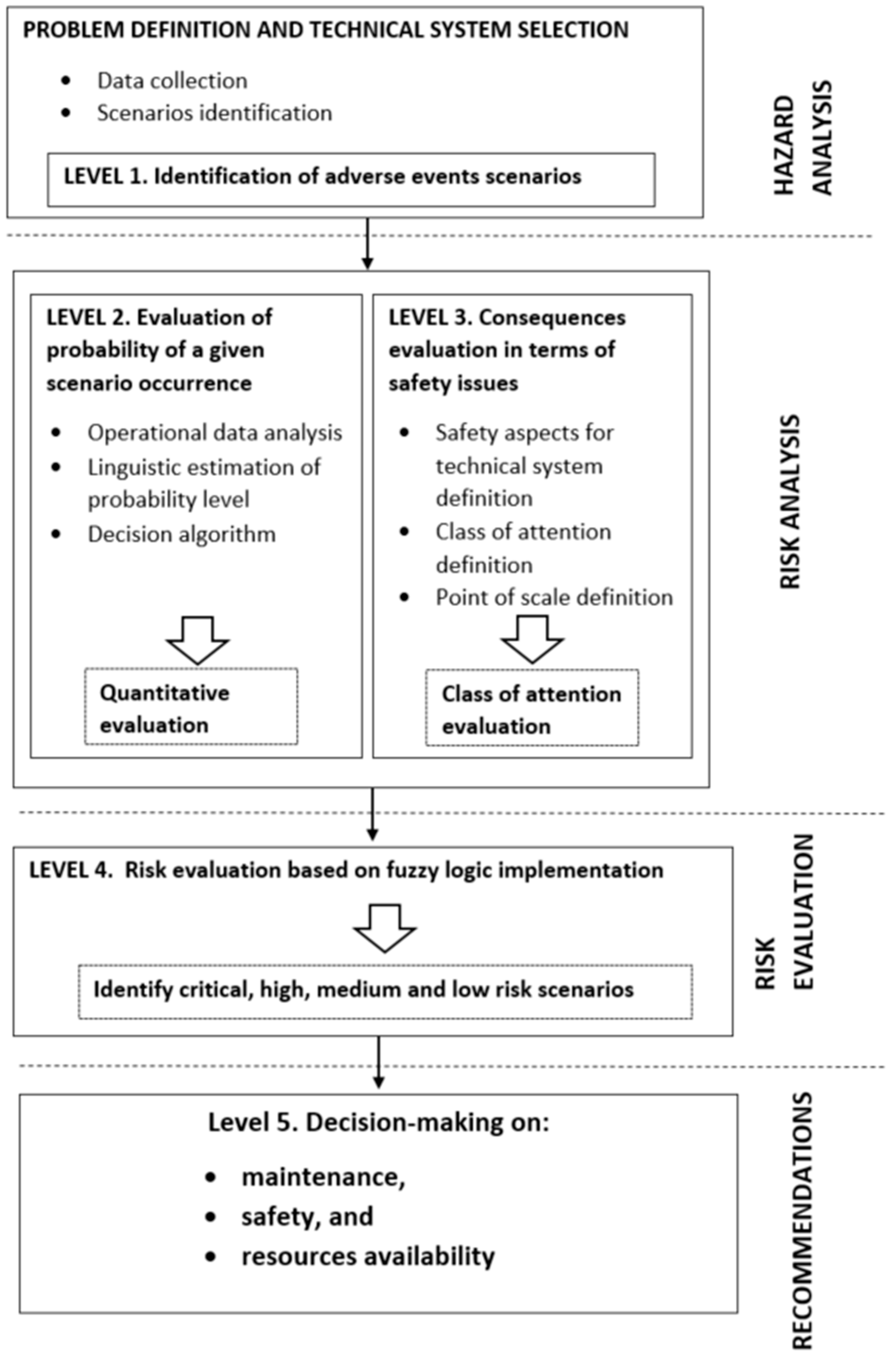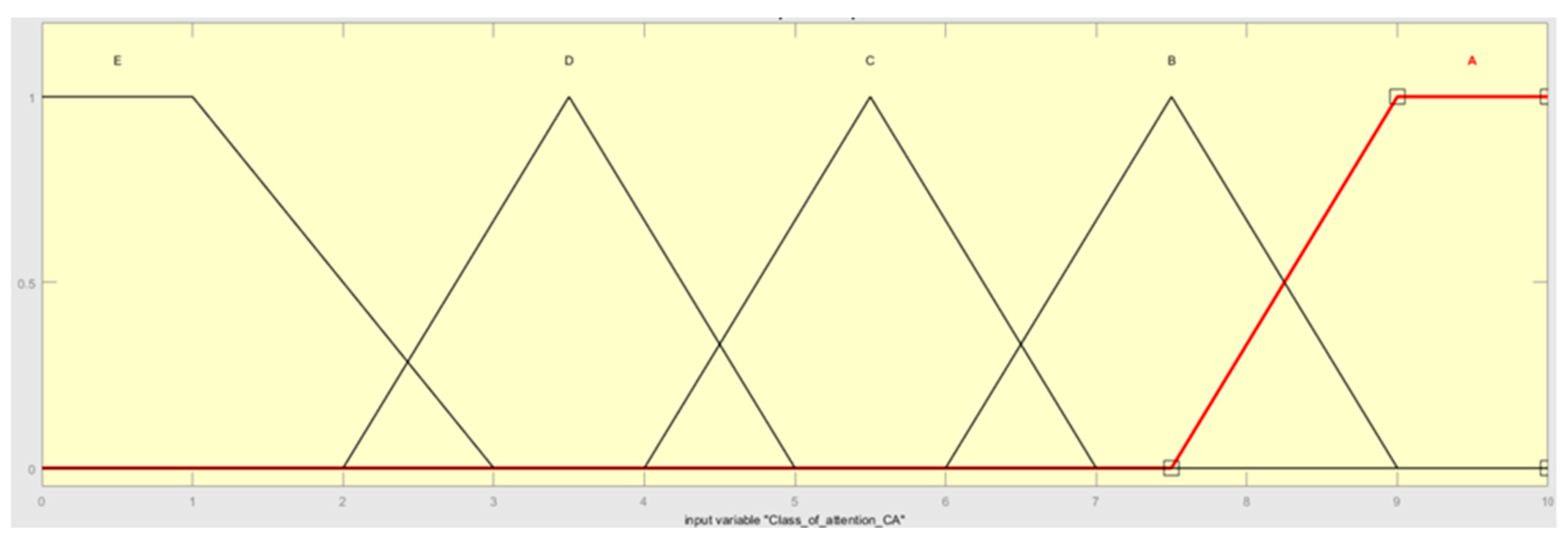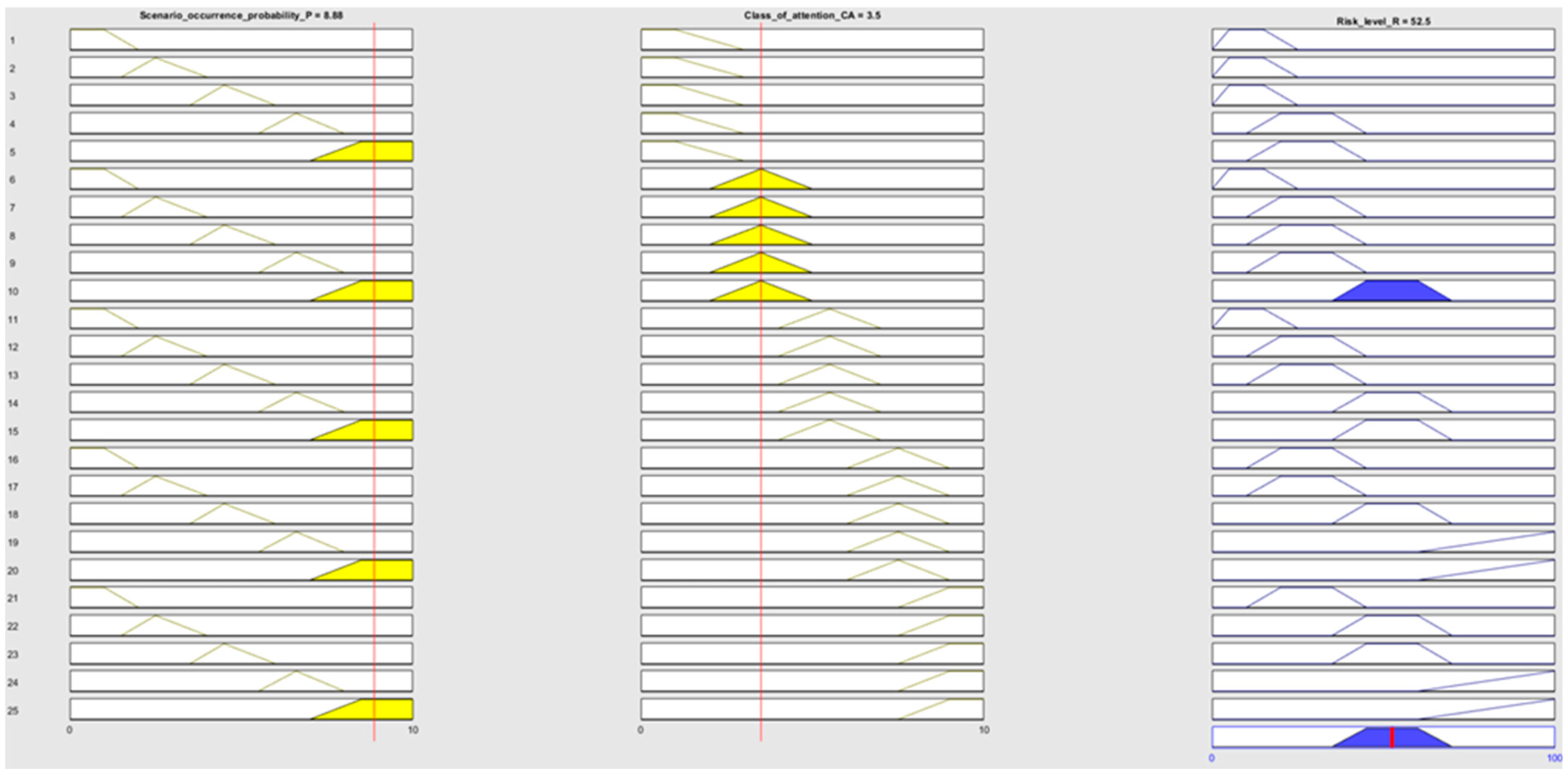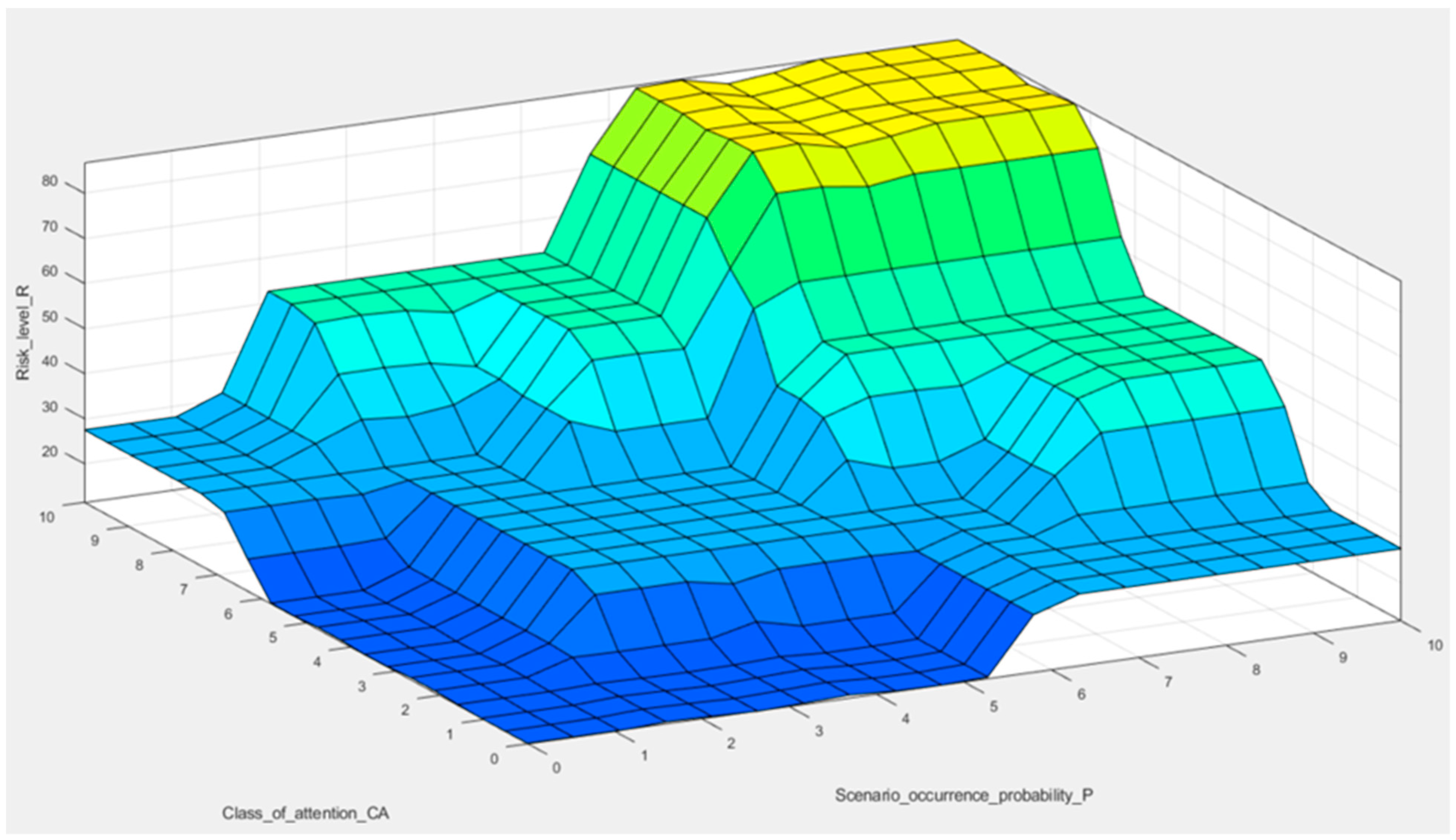Additionally, the proposed solution is based on the fuzzy logic approach with the use of triangular fuzzy numbers. This requires a theoretical background to be provided in this area.
3.2. The Main Phases of the Proposed Fuzzy RBM Methodology
The first level of the analysis is to identify undesired events that may occur in connection with the operation process of the analyzed mining machines. Their description is in the form of scenarios, as the proposed method uses in the risk assessment the scenario approach proposed by Kaplan and Garrick [
4]. Therefore, the risk is defined as:
where:
R—risk; {}—must be interpreted as a “set of”;
Si—
ith scenario (undesirable event) description;
Pi—the probability of
ith scenario occurrence;
Ci—the measure of consequences or damage caused by the
ith scenario;
N—the number of possible scenarios.
Based on historical data, service documentation, and benchmarking analysis, individual adverse event scenarios are identified that should be subject to further analysis in the opinion of managers. At this stage of the procedure, it is recommended to use selected qualitative methods that are described, among others, in the ISO 31000:2018 standard [
64]. Based on the experience gained within the SafeMe4Mine project, among the recommended methods it is suggested to use: (1) the “
What—
if” method (SWIFT), (2) the check-list method, and (3) the HAZOP method. Prepared scenarios should primarily concern the failure of individual subsystems or critical elements of the machine.
The starting point for Level 2 analysis is the computerized maintenance management system handling the available data about the occurred failures and the conducted inspection/planned/corrective maintenance in the analyzed period. On this basis, it is possible to estimate the probability of occurrence of the identified adverse event scenarios.
The probability of occurrence of a given scenario is estimated according to the algorithm presented in
Figure 4. The procedure follows two steps and assumes that: (1) the lack of failure in the analyzed past period increases the probability of its occurrence in future periods; (2) the replacement of failed elements with a used/refurbished part or their so-called imperfect repair (e.g., minimal repair) increases the probability of their failure in future; (3) lack of results from the conducted periodic inspection after the last performed repair increases the probability of failure (lack of information increases the uncertainty of the decision made). The first step of the probability estimation is based on the failure history of a system/element. If there was no failure, the probability of a given scenario occurring should be estimated at the level P4 (Likely to happen in the near time). When the failure was identified and repaired, the probability estimation follows the P3 level (possible to occur in the near future). If the failed element was replaced by a new one, the Pi level equals P1, otherwise, it equals P2. The first step of the decision algorithm ends with the definition of max Pi level, which was estimated based on the reasoning process.
The second step is based on the results obtained from periodic inspection performance. Based on the results from the first step (max Pi) and the decision process from the second step, the final probability of the unwanted scenario occurrence is defined.
According to the decision algorithm, the probability can take levels from P1 to P5, with the following linguistic notation being assigned to the next levels (
Table 2).
The managers should determine the attention class defined for each scenario, based on the selected ranking criteria. In the mining sector, the determination of the attention class should take into account the potential consequences of an adverse event occurring, taking into account numerous safety aspects. In terms of process safety, consequences can be defined as damage to property or assets, human health loss, toxic release, environmental harm, damage to the company’s reputation, and production loss (see, e.g., [
6,
54,
65]). In the study by [
46], four major categories for consequence analysis are included: human loss, economic loss, environmental damage, and reputation. Personnel, equipment, operation, and environment are investigated in work [
66]. Considering such approaches and based on mining sector conditions, in this study, the consequences are investigated in relation to the three main aspects—human loss, the time taken to take the machine out of service (downtime and production delay), and economic loss (including assets, property, production, and reputation). As a result, the definitions of the consequences in relation to the three main groups of effects, namely, human consequences, machinery, and costs, are presented in
Table 3.
During this phase, the main steps are collecting expert opinions and implementing a fuzzy model to evaluate the risk ratio for all the identified unwanted scenarios. One potential issue to consider at this stage is the assessment of experts in terms of their knowledge, experience, and availability. On the one hand, the results obtained will allow assessing whether weighting factors for experts should be introduced. On the other hand, the results obtained may influence, e.g., the estimation of the optimum number of expert scores required to reach a judgment. This problem is considered, among others, in the work [
66]. First, the experts provide their opinions for the defined risk assessment parameters. The experts’ opinions are collected using linguistic scales. The proper definition of linguistic input variables is based on expert knowledge and the description given in
Table 2 and
Table 3.
When the expert opinions are collected, the fuzzy set theory is used. According to the preliminaries defined in
Section 3.1, the proposed solution is based on triangular FN use for input variables and trapezoidal FN for the output variable. Following
Figure 5, the basic structure of the fuzzy logic system (FLS) includes three main parts: fuzzification, the fuzzy inference system (FIS), and defuzzification [
56].
The first process connected with fuzzification decomposes input variables (scenario occurrence probability (P), class of attention (CA)), and one output variable (risk (R) categories) with crisp numbers into fuzzy sets (P, CA, R). In the current work, the authors decided to use triangular and trapezoidal FNs, due to their ease of application and versatility. The two input variables, P and CA, are described linguistically in
Table 2 and
Table 3. The fuzzy sets for variables P and CA are presented in
Figure 6 and
Figure 7.
There are also defined four main categories for risk level. According to these categories, the risk is ranked as low (tolerable/acceptable), significant, high, and critical (intolerable/unacceptable). Risk fuzzy sets are conducted according to expert opinions, by our own analysis, and are presented in
Figure 8.
Table 4 shows the range of linguistic variables proposed for the decision-making process.
Usually, a single manager or engineer cannot consider all relevant aspects of an underground mine. Following this assumption, risk assessment in the mining sector involves experts with different backgrounds and experiences, who may have different opinions on the final judgment. As a result, it is necessary to aggregate all experts’ opinions to get an overall quantified value. According to [
52], the aggregation of expert opinion can be performed using the arithmetic mean aggregation operator. The mean aggregation operator, defined in fuzzy triangular numbers (
a1,
b1,
c1), (
a2,
b2,
c2)… (
am,
bm,
cm), delivers the result as (
x,
y,
z) according to the formula:
In this paper, the authors do not consider expert weighting. However, in a scenario where it is possible to use the evaluation of experts with different levels of knowledge and experience, it is recommended to introduce weighting factors for their evaluation. More information about experts’ fuzzy opinions’ aggregation may be found, e.g., in [
67,
68].
The second part of the FLS is the fuzzy inference system. It maps fuzzy input tests into fuzzy output sets using a knowledge base [
69]. The proposed solution is based on the Mamdani-type fuzzy engine and the “IF-THEN-ELSE” rules, established based on human knowledge and mathematical calculus. The definition of the If-Then rules based on the risk decision matrix is presented in
Table 5. Following this method, 25 rules can be defined. According to this system, for example, rule 1 is defined as:
IF Scenario occurrence probability is P1 and Class of attention is E, THEN Ri level is Low.
Table 5.
Risk decision matrix for “IF-THEN-ELSE” rules definition.
Table 5.
Risk decision matrix for “IF-THEN-ELSE” rules definition.
| Scenario Occurrence Probability | P5 | SIGNIFICANT | HIGH | HIGH | CRITICAL | CRITICAL |
| P4 | SIGNIFICANT | SIGNIFICANT | HIGH | CRITICAL | CRITICAL |
| P3 | LOW | SIGNIFICANT | SIGNIFICANT | HIGH | HIGH |
| P2 | LOW | SIGNIFICANT | SIGNIFICANT | SIGNIFICANT | HIGH |
| P1 | LOW | LOW | LOW | SIGNIFICANT | SIGNIFICANT |
| | E | D | C | B | A |
| Class of attention |
Due to the use of the Mamdani model, the FIS was based on MIN and MAX operator implementation. The MIN operator was used for combination and implication operations. The MAX operator was used to aggregate the fuzzy outputs. Additionally, the MATLAB fuzzy logic toolbox was used to build a FIS for the RBM modeling.
The last part of FLS is the defuzzification process. During this process, the obtained fuzzy outputs into crisp values are based on a known defuzzification method. Widely used defuzzification methods include, among others, centroid average (CA), the center of gravity (COG), the mean of maximum (MOM), or largest of maximum (LOM). A survey of the most commonly known defuzzification methods is presented, e.g., in [
70]. The authors propose to use a COG method due to its simplicity and providing a better solution than other methods. Thus, the crisp output is estimated as [
52]:
where:
z*—the crisp value for the
z output (defuzzified output);
—the aggregated output membership function;
z—the universe of discourse.
After the defuzzification process, the FIS gives a crisp output value to express the risk level of the associated hazard scenario occurrence. Following this, the proper actions can be ordered, based on the definition of recommendations.
The obtained results from Level 4 are the basis for defining the main recommendations for a decision-maker. What is also essential is how strongly the results of Level 5 and decisions are taken depend on how deep the so-called “risk appetite” of managers will be, which determines risk perceptions. The risk perception of decision-makers determines the value of acceptable risk in machine maintenance processes. In some mines, the acceptance level will be set on a “Significant risk” line, while in others, the acceptable acceptance level will be set only at “Low risk”. Research indicates that risk perception depends on many characteristics of decision-makers, such as age, gender, and education [
71]. Therefore, it is recommended that risk analysis teams should be composed of various representatives of the company.
First, based on the obtained risk scores, the decision-maker should also be able to interpret the obtained values correctly.
Table 6 describes the possible risk levels in a proposed 4-grade scale.
With this understanding of the risk score, it is possible to identify basic recommendations. The main recommendations based on risk level evaluation can be defined, considering the aspects of maintenance, safety, and resource availability/allocation. This approach will allow a comprehensive view of the mine maintenance problem.
For analyses where the risk ratio assumes values accepted by managers, the most common maintenance recommendations are the following maintenance policies, defined by a producer/implemented in a company. From a safety point of view, it is sufficient to introduce risk-reporting (periodic). Additionally, there is no need to introduce any changes to the current inventory policy; managers should also base their decisions on the available resources.
When the obtained level of risk ratio is higher than the acceptable level, the proposed recommendations should satisfy reliability and safety assumption criteria. For the scenarios where the risk level is at least “Significant,” it is necessary to change the machine maintenance standard. The scope of these changes depends on the value of the estimated risk. In case of a “Significant” threat, the changes usually concern a revision of the inspection interval (e.g., shortening the time between periodic inspections) or increased attention to certain elements during the current inspection performance (daily machine maintenance). However, in the case of scenarios with a “High” or “Critical” risk level, the actions taken to reduce this risk should concern not only periodic inspections intervals revision but should also redefine the scope of the condition monitoring and maintenance work carried out. Those recommendations focused on safety and resource allocation/availability should also be carefully developed and implemented. The appropriate recommendations in these two areas will depend on the type of organization (mine type), its physical assets and should be compatible with ISO 5500x standards indications.
Following this, the general areas for recommendations may be compatible with the safety levers presented in, e.g., [
6]. The defined safety levers are compared with the assessed risk level (
Table 7). Additionally, the general recommendations in relation to the three defined issues—maintenance, safety, and resources availability—are presented in
Figure 9. The most crucial improvements are indicated according to the obtained risk level. At the same time, it should be remembered that these recommendations should be considered in terms of three dimensions: persons, system, and machinery.





















